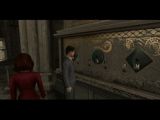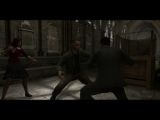Even before its release, The Da Vinci Code video game had a lot to live up to.
Almost 40 million people have bought Dan Brown's best-selling novel and, despite lukewarm reviews, the film looks set to become a summer blockbuster. With that kind of track record it would be difficult to deliver a dud. But The Da Vinci Code game certainly makes an effort to do just that. The game promises players the chance to break the code for themselves, as they try to solve a murder mystery that has its origins more than 2,000 years ago.
In reality, gamers are served up an often frustrating movie tie-in, with endless cut scenes and patchy gameplay. At times it feels tedious, and at others like the ancient mystery is being played out in real time.
But despite its glacial pace, the game makes a good stab at recreating the mood of the original story and gives gamers a chance to explore Dan Brown's world in detail. With the Da Vinci fever at an all-time high, that alone may be enough to guarantee this game's success.
Crack the puzzle Gamers familiar with the novel will recognize the basics of the plot as you set out to solve the bizarre murder of Jacques Sauniere in the Louvre Museum in Paris. However, game developers the Collective have added extra locations and puzzles to appeal to gamers who do not just want a walkthrough of the novel. You play as either Harvard Professor Robert Langdon or Sauniere's cryptographer grand-daughter, Sophie Neveu, as you make your way around 11 chapters of familiar locations solving cryptic posers as you go.
Disappointingly the game only offers a single-player mode.
Players used to online puzzles will quickly adapt to this game, moving characters around the locations looking for objects that deserve a closer examination. On finding one, your character slips into examination mode, allowing you to pore over pieces of furniture, statues and stained glass windows. Providing you have collected the relevant objects, you might unlock another puzzle or find a clue to a later conundrum.
As you would expect, these anagrams, ciphers and puzzles form the backbone of the game and are clearly where most of the development effort has gone. At times they can be gallingly hard, particularly for people who have not read the book or seen the film. At times, players are reduced to pure guesswork by the needlessly elaborate clues.
That said, there is a certain sense of satisfaction when you are confronted by Da Vinci's Vitruvian Man that signals when you have solved a particularly complex riddle. But the game falters between these brief highs.
The vast majority of play involves aimlessly wandering around churches, art galleries and stately homes hoping to stumble across an object of interest. This can lead to long periods of play, endlessly retracing your steps and painstakingly poring over rooms in the hope that you will trip over the missing object.
Until you have completed the required tasks in a particular section you cannot move on through the game. These tedious walkabouts are occasionally punctuated by formulaic fighting sequences that seem out of place and, at times, tacked on as an afterthought. During these struggles, gamers are reduced to following specific sequences of buttons, rather than following the action on screen. Visually, the game is good with fairly accurate and detailed recreations of famous locations including the Louvre Museum and Westminster Abbey.
Too dark
The main gripe is that because a lot of the action takes place at night or inside churches and mansions, the screens often appear too dark to really appreciate the attention to detail. The sound is good and the accompanying music lends a suitably ethereal atmosphere to proceedings. Another nice touch is the encyclopedia of key places, historical facts and clues that builds up as you make your way through the game.
This lends the game a semi-intellectual air that should appeal to Da Vinci Code fanatics. Further bonus material such as concept artwork and extra puzzles can be unlocked by collecting Da Vinci's inventions and other secret artifacts.
These objects are not necessary to complete the various levels and so offer a further challenge to keen code breakers. And it is really these die-hard fans that this game should appeal to. The gameplay in this adaptation is too inconsistent to tempt seasoned gamers. For Da Vinci devotees who just cannot get enough of the obscure conundrums that form the basis of the book, this game will offer a beguiling, and at times illuminating, addition to Brown's cryptic world.
>

 14 DAY TRIAL //
14 DAY TRIAL // 

